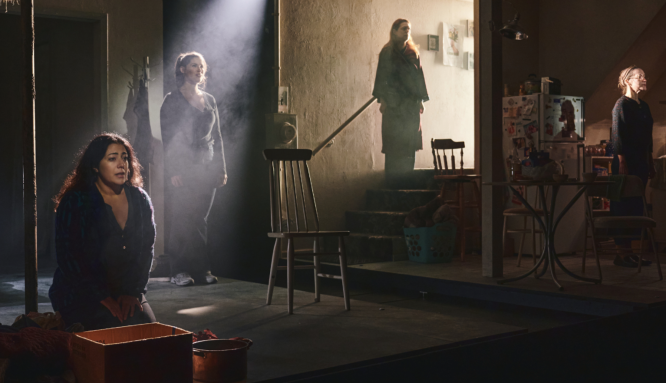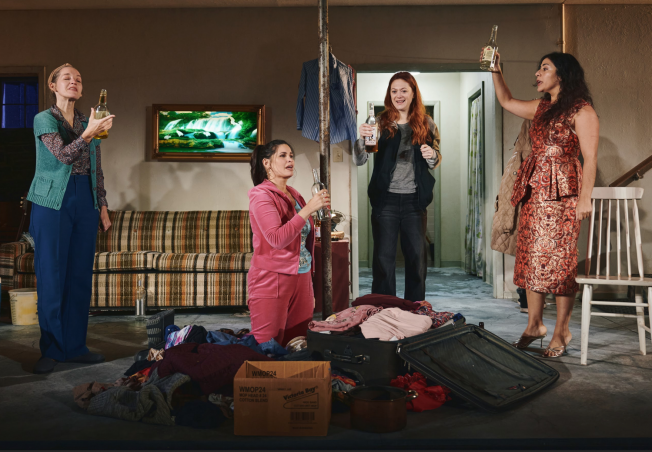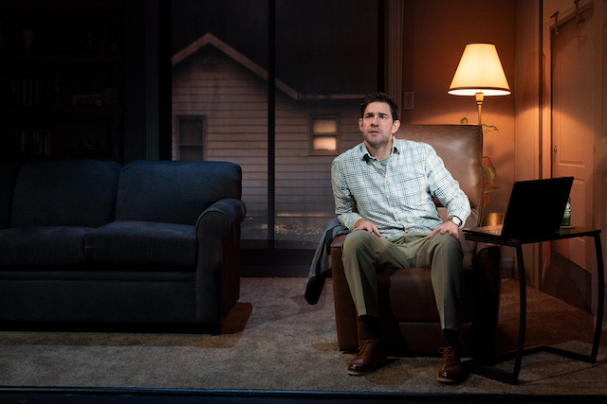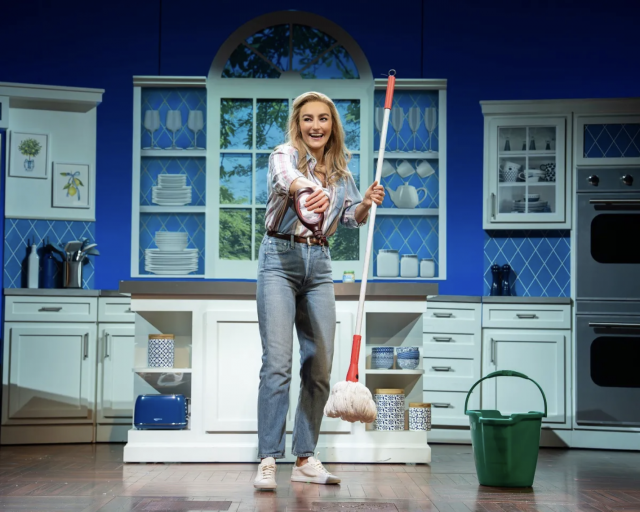
Nadine Malouf, Nicole Villamil, Marin Ireland, Brooke Bloom (Photo: Valerie Terranova)
Queens
By Carol Rocamora
“Do you think it’s worth it to be here?”
That is only one of the many probing, painful questions posed in Queens, Martyna Majok’s lacerating 2018 drama about immigrant women in crisis, now playing in an updated version at Manhattan Theatre Club.
Set in the basement of a boarding house in Queens, the play gives a glimpse into the fragile, endangered lives of six immigrant women who have sought refuge in America. They come from all over the world, leaving their families and children behind to start a new life. Their purpose: to gain citizenship and jobs, to send money home, and ultimately to bring their children here. Their pasts are fraught with hardship, making their hopes of finding and living the American Dream even higher.
But, as one woman warns: “You don’t know what life can be like in America.” They are about to find out – and so are we, from their traumatized perspective.
Martyna Majok, the playwright and an immigrant herself, knows whereof she writes. She sets her play over a time period spanning from 2001-2017, during which we follow the story of Renia, who arrives at the boarding house from Poland just a few months after 9/11. As played with all-consuming intensity by Marin Ireland, Renia meets the other basement residents, including Pelegiya from Belarus (a stern Brooke Bloom) and Aamani from Afghanistan (an emotional Nadine Malouf). A fourth resident, Isabela (Nicole Villamil), is packing to return to her home in Honduras to take care of the daughter she misses. Though alternately wary and mistrustful of one another, they take a moment’s respite together to toast Isabela upon her departure, dressing in whatever ragged, random finery they have in their suitcases and drinking from liquor bottles left in the apartment by former residents. This unexpected celebration bonds them closer together, as they show each other a desperately needed compassion for their shared economic and personal hardships.

Brooke Bloom, Nicole Villamil, Marin Ireland, Nadine Malouf (Photo: Valerie Terranova)
One of the challenges in following their moving stories is the play’s structure. It jumps back and forth in time – beginning with the arrival of Inna (Julia Lester) from Ukraine in 2017, who has fled a Florida man (who sponsored her travel to the US) and walked (literally) from Palm Beach to New York City. She came to the US to look for her mother, who had come here years ago but stopped contacting Inna. There’s also the surprise arrival of Isabela’s adult daughter (Sharlene Cruz), who has let herself into the apartment with her mother’s key (indicating that the story of immigration continues).
The reverse chronology, as well as the introduction of two other ancillary female characters along the way, can be hard to follow. But the spine of the story – Renia’s journey over sixteen years – is so strong that it holds our attention and deepens the play’s troubling themes. At first a victim like the others, Renia turns heartlessly against her flat–mates. Determined to have the prosperity that the American Dream promises, Renia forms a relationship with the owner of the house (whom we never meet), and, after the latter is moved into hospice, tricks her into passing on the ownership to Renia. Her economic triumph is hollow, however; she has lost the trust of her fellow immigrants. Moreover, Renia cannot convince her daughter, now grown and living in Kraców, to come to the USA and join her. For Renia, the American Dream has become an American nightmare.
Trip Cullman directs the all-female ensemble on Marsha Ginsberg’s ingenious set, which splits in two as time frames and locations change, providing a third platform for scenes outside Queens. Some of the most moving moments occur when the ensemble steps out of time on that platform, facing the audience, calling out to family members they may never see again.

Julia Lester, Marin Ireland (Photo: Valerie Terranova)
It’s no surprise that immigration is becoming a frequent, urgent subject in new drama. Majok herself is the author of other plays about the immigrant experience (Ironbound and Sanctuary City). Nigerian-American playwright Mfoniso Udofia has written four plays – Sojourners, Her Portmanteau, runboyrun, and In Old Age – as part of her nine-play “Ufot Cycle” of plays on the Nigerian immigrant experience in America. British writers Joe Murphy and Joe Robertson have offered us stunning immersive works about the refugee crisis, including The Jungle (2015) and The Walk (2021).
Living as we do today with the brutal new immigration policies that the current US administration is imposing, Queens feels as if it were written in another time (as indeed it was). The vicious hunt for so-called “undocumented immigrants” and terrifying images of violent, unlawful ICE arrests are flooding our everyday lives. The threat that these cruel policies pose are real and present, but are understandably absent in the world of this play.
On the other hand, Queens has an existential, universal quality that transcends time and place. Majok’s play reminds me of The Lower Depths, the 1902 Russian drama by Maxim Gorky. Like Queens, it takes place in a boarding house where impoverished people from all walks of life live and lament together. Like Queens, it features lost souls in stasis, suffering from their past, facing an uncertain future. Their only comfort is that they are together.
Meanwhile, immigrants may be in danger on the streets of America today, but they are safe on our stages. Clearly, they are here to stay.
At New York. City Center Stage 1
131 W. 55th St
2 hours 15 minutes, one intermission
Through December 7, 2025




